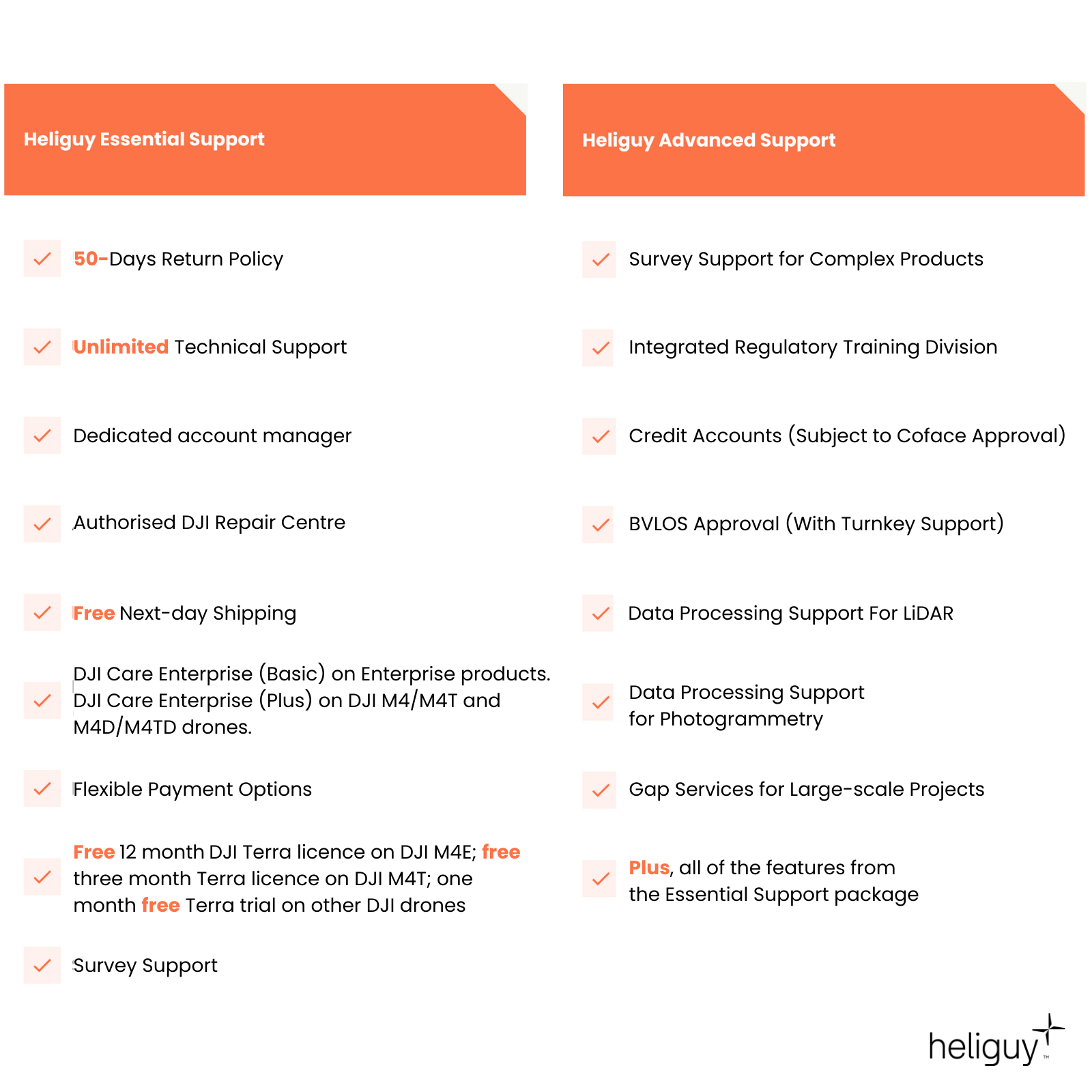DJI Dock (with DJI M30T)
£0.00
Tax included in UK & Shipping calculated at checkout
50-days return policy
Next-day delivery - order before 3 pm
DJI Dock is a drone-in-a-box solution that allows automated flights with the DJI M30T drone - opening up possibilities for fully-automated and pre-programmed flights.
DJI Dock with M30T Deploy DJI M30T with DJI Dock for a versatile data-capture solution. DJI M30T has wide and zoom cameras, a thermal sensor, and laser rangefinder.
About This Combo Includes DJI Dock, DJI M30T drone, and wind speed gauge. For a non-thermal option, choose DJI Dock with DJI M30 drone.
heliguy™ - Your DJI Dock Partner As a DJI Dock partner, heliguy™ offers site visits, installation and supply; maintenance/repairs with DJI Dock accredited technicians; SLAs; and training, including UK SORA (formerly OSC) consultancy for BVLOS operations.
Overview
Contents
Specifications
Support
FAQ
Heliguy Services
DJI Dock With DJI M30T Key Features
Automated and remote drone operations
On-demand Data Collection: DJI Dock can operate 24/7, day or night, rain or shine.
Cloud Control: Schedule flights or fly on-demand and centralise data, using software such as DJI FlightHub 2.
Fast Recharging: DJI M30T automatically charges in the dock and is ready to fly 25 minutes after landing. Fully charged, the M30T flies for 40 minutes.
Waterproof Design: The Dock is IP55 and the core internal components IP67, making it waterproof and dustproof even when it is open. The M30 Series Dock Version has a max wind resistance of 15 m/s and an IP55 rating.
Versatile Data Capture: The M30T (Dock version) integrates a 12MP wide camera, 48MP zoom camera, a 640 x 512 px thermal sensor, and 1,200m laser rangefinder.
Environmental Adaptability: The Dock's interior is climate-controlled for safe charging temperatures, even when the outside climate is -35°C to 50°C.
4G Connectivity: Dock connectivity can be expanded with an optional external 4G dongle.
Emergency Power Supply: In case of a power outage, the Dock's internal battery will take over and keep the dock operational to make sure the M30T lands from its mission.
Integrated Design: DJI Dock has a wide-angle security camera, integrated weather station, internal omni-directional antenna, RTK module, and edge computing expansion slot.
Cloud API: Cloud API opens up Dock functionality to developers and system integrators, who can set up a custom, private server.

DJI Dock Workflows
Automated Inspection and Remote Deployment.
Automated Deployment: DJI Dock will automatically deploy a fully-charged M30 Series drone to conduct your inspection mission.
Remote Data Capture: Automonmously & remotely capture inspection data and images of your target subject.
Real-time Data Sharing: Real-time data sharing through cloud-connected management software allows instant data transfer and reporting.
Return to Home and Recharge: The Matrice 30 Series drone will autonomously land back on its DJI Dock and begin recharging its batteries for the next mission.

DJI Dock
Benefits of Automated Deployment
Operational Flexibility: Conduct persistent, scheduled, round-the-clock data collection or gather spontaneous, on-demand situational awareness whenever necessary - unbound by the availability of pilots or employees.
Improved Cost Savings: Reduce operational costs and maintain business continuity and operations from anywhere in the world as on-site drones collect consistent, accurate and repeatable data - all managed from afar, centralising data.
Rapid Deployment: Permanently sited, on-location, autonomous solutions are ready to deploy on demand, reducing the logistical burden of getting personnel and equipment to site.
Enhanced Safety: Remotely-operated drones perform risky tasks in dangerous areas or hard-to-reach locations, keeping personnel away from hazardous situations and enabling data collection in otherwise inaccessible zones.
Repeatable Data: Automate missions to ensure your on-site robots collect accurate and repeatable data more frequently.
Environmentally Friendly: Remote and automated drones are an environmentally friendly way of collecting data.

DI Dock Use Cases
The future of data collection
Security and Surveillance: Conduct persistent surveillance along predefined routes or launch the drone from your Dock for on-demand monitoring.
Mining: Remote monitoring facilitates regular scheduled inspections to an immediate response in an emergency situation.
Oil and Gas: Deploy autonomous drones on pre-scheduled missions to detect leaks, faults, structural damage, environmental hazards, failures, and other faults immediately - removing the need to put workers in dangerous situations.
Construction / Infrastructure: Monitor site productivity with persistent visual data streams and centralised digital data management, facilitating remote monitoring and inspection to enforce safety protocols, enhance on-site staff safety, and ensure compliance with safety regulations.
Ports and Terminals: Conduct routine inspections and continuously monitor shipping lots, manage container inventory, and inspect crane operations and unidentified freights. Access hard-to-reach areas to enhance safety and awareness.
Utilities: Automate utility asset inspection and incident-based alerting. Monitor and inspect remote substations with 24/7 live access, reducing travel time, risk, and costs. Implement automated inspection reports to facilitate preventative maintenance planning.

DJI Dock Implementation Pathway
How heliguy™ supports your DJI Dock integration
Extensive Training: Learn how to operate the DJI Dock and obtain the relevant drone training certificates by receiving application-focused training from the experienced heliguy™ drone training team (including BVLOS).
Dock Siting Assessment: Conduct a thorough assessment in conjunction with heliguy™ to ensure you site the Dock(s) at an appropriate location and with the correct infrastructure. This assessment also includes server and data deliverables.
Safety Management: heliguy™ will assist in developing a robust safety management system and help you develop comprehensive operating procedures.
Legal Authorisation: Obtain the relevant permissions to operate the DJI Dock legally and safely. This includes an Operating Safety Case (OSC), CAA exemption and airspace authorisation, a process heliguy™ will guide you through.
Maintenance And Repairs: heliguy™ has official DJI-accredited Dock technicians, helping to keep your equipment in working order and ensuring operational continuity.
Service Level Agreements: heliguy™ offers exclusive Service Level Agreements, offering robust support mechanisms during your DJI Dock lifecycle.

DJI Dock
DJI Flighthub 2
DJI FlightHub 2 unlocks the full functionality of the DJI Dock, offering complete cloud control and enabling remote operations. Schedule missions, create and edit flight routes, and manage your collected data.
Real-time Awareness: Live stream in HD anytime to check on your DJI Dock or your drone.
Mission Planning: Plan complex flight routes remotely through DJI FlightHub 2.
Flight Plan Management: Edit, manage and push flight routes to your DJI Docks and keep track of flight progress and results.
Media Management and Storage: Review the geo-tagged pictures, videos, maps and panoramas collected by your drones. The drone data can be automatically uploaded and stored for later use.
One-stop Operation and Maintenance: Monitor the health and status of your DJI Docks and drones remotely from the cloud.

DJI Dock Third-party Support
Integrate with non-DJI Software
DJI Dock can utilise non-DJI software platforms. These solutions include FlytBase and Drone Harmony.
FlytBase: Drone autonomy software platform. Monitor your DJI Dock fleet in real-time, track your aircraft, receive real-time alerts, oversee your drone operations, and centralise data. FlytBase offers enterprise-grade data security, including cloud, in-country cloud, on-premises, or air-gapped deployment options.
Drone Harmony: Enterprise software platform. Conduct automated flight planning in a 3D interface. View live feeds and conduct fleet management. Drone Harmony has robust data security protocols, including air-gapped solutions.

DJI Dock: Recommended Extras
Complete your purchase with...
Accreditation
![UK CAA Recognised Assessment Entity (RAE)]()
UK CAA Recognised Assessment Entity (RAE)
Authorised GVC/A2 CofC Training Courses
![UK CAA Permission for BVLOS Flights: Operational Authorisation UAS 15435]()
UK CAA Permission for BVLOS Flights: Operational Authorisation UAS 15435
Helping companies unlock BVLOS missions in an AAE with DJI Docks
![The UK's only DJI Gold and S-Level Partner]()
The UK's only DJI Gold and S-Level Partner
Trusted supply on DJI products
![ISO 9001 Certification]()
ISO 9001 Certification
Driving industry standards through robust operational protocols for enhanced safety and reliability
![Training Qualifications UK]()
Training Qualifications UK
Accredited training courses endorsed by TQUK.
![Ofqual-regulated Training]()
Ofqual-regulated Training
Recognised quality mark for meeting accreditation criteria.
![Cyber Essentials]()
Cyber Essentials
Verified data security
![Financial Conduct Authority]()
Financial Conduct Authority
Authorised to conduct regulated financial services
![Armed Forces Covenant Defence Employer Recognition Scheme - Silver Award]()
Armed Forces Covenant Defence Employer Recognition Scheme - Silver Award
Proud supporter of our Armed Forces
![D-U-N-S Registered: 77-916-1210]()
D-U-N-S Registered: 77-916-1210
Verified to conduct international business









